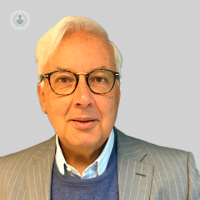Using your own fat for a natural breast enhancement
Escrito por:Performing breast augmentation surgery using the body’s own fat began in the 1980s, pioneered by American dermatologist Sidney Coleman. Since then, the procedure has been refined by other surgeons and nowadays in the USA, approximately 20% of breast augmentations are performed using this technique – by taking fat from one part of the body and transferring it to the breasts, negating the need for implants and more invasive surgery. Mr Alberto Di Giuseppe is a leading plastic surgeon who is an expert in performing natural breast enhancements.
How is the fat removed?
The fat used to augment the breasts is removed using VASER technology which allows removal of fat without damaging underlying structures responsible for innervation and circulation of blood to the skin. VASER is a minimally-invasive technique of liposculpture which eliminates unwanted fat, whilst reusing this fat to enhance the breasts. This can be carried out under general anaesthesia or local anaesthesia with sedation.
Fat is usually taken from the abdomen, hips or back, however, sometimes it is also taken from the arms, thighs or buttocks. However, it is essential that the location where fat is taken from has enough, as a certain amount of adipose (fatty) tissue is needed to perform the subsequent breast augmentation. Generally, 400-600ml of fatty tissue is needed to perform a breast augmentation to maintain sufficient tissue amounts after it has been washed and filtered of impurities (e.g. blood, anaesthetic and triglycerides).
The fatty tissue is removed through micro-incisions, into which a suction cannula with a blunt tip is inserted. Using a gentle approach, fatty tissue is removed and collected.
The natural breast enhancement:
The fatty tissue is inserted into the breast through very small incisions which leave nearly invisible scars. The fat is inserted both on the surface and deeper into the space between the mammary gland and the pectoral muscle. This achieves a natural-looking result and allows the shape of the breast to be contoured according to the patient’s wishes. Additionally, asymmetry of volume and shape can be corrected too. This technique is much less invasive than a conventional mammoplasty, and much less painful too.
Following surgery, there will be some swelling for around three weeks. It is not advised to compress the breasts because this can damage the transplanted fat cells. Patients should also refrain from strenuous physical activity to avoid either damage to the breasts and to prevent ‘burning’ the fat just moved.
When performing the procedure, slightly more fat is transplanted than necessary because approximately 70% of the tissue will survive.
The transferred fat tends to behave like the fat from where it was taken and hence excessive weight loss or hormonal changes during pregnancy or menopause can affect the transferred fat.
After surgery:
Is likely that immediately after surgery the treated area will be swollen and numb. This will return to normal within a few days. The micro-incisions through which the cannula was inserted are sutured and eventually these become almost invisible. The anaesthetic used ensures the patient does not feel pain in 24-48 hours following surgery, following which any discomfort can be managed with regular painkillers. The first two days should consist of resting and if necessary non-physical work can resume on the third day. Showering can commence from the third day as well. Sport and physical activities can be resumed gradually from around 3-4 weeks following surgery.
The following contraindications will rule out a patient’s suitability for this type of breast augmentation:
- Lean subjects, with areas of fat removal insufficient
- Patients with a family history of breast cancer
- Patients that focus the inquiry on volume rather than on the naturalness of the result obtained through breast augmentation
- Patients with bleeding disorders
- Signs of infection or inflammation
- Neoplasms are present (new and abnormal tissue growths)
- Radio-chemotherapy has been had by the patient previously
- Patients with certain psychiatric conditions
If you are interested in this type of breast augmentation, make an appointment with an expert.



